This post may contain affiliate links. If you use these links to buy something we may earn a commission. Thanks.
The number of tomatoes to plant per person can be calculated using averages. Average family consumption, average yield, average care, and an average performing climate.
The answer to precisely how many tomatoes to plant seems ‘impossible’ to determine—but, with any variable matter, such as gardening, averages are the answers we’re looking for!
I’ve been there, wondering how many plants to grow, and feeling like all the charts saying you should plant “4 tomatoes per person” are completely irrelevant (because they are).
You don’t eat tomatoes as I do, and I don’t eat tomatoes as you do, so I won’t be providing you with a baseless chart on how many tomatoes I think you should grow.
Instead of handing you the wrong fish, I’ll teach you how to fish the right fish for you.
You’ll determine a reasonable number of tomatoes to grow based on what your family needs.

The averages to account when planting per person are:
- How many tomatoes grow per plant on average
- How many tomatoes your family eats on average
- How often you’ll eat tomatoes on average
- Average tomato training and care techniques
- Average environmental conditions for tomatoes
- How many tomato plants will maximize your grocery savings
Implementing these steps into our planning has us on a streak of growing just the right amount of tomatoes every year for the last 3 years.
Planning tomato harvests
You’ll need to decide if determinate or indeterminate tomatoes are best for your needs.
Indeterminate tomatoes take longer to grow before they begin to fruit and continue to produce new fruit until frost takes them out. You’ll have a steady supply of fresh eating tomatoes with indeterminate types.
Your harvests will look more like a consistent supply of this:
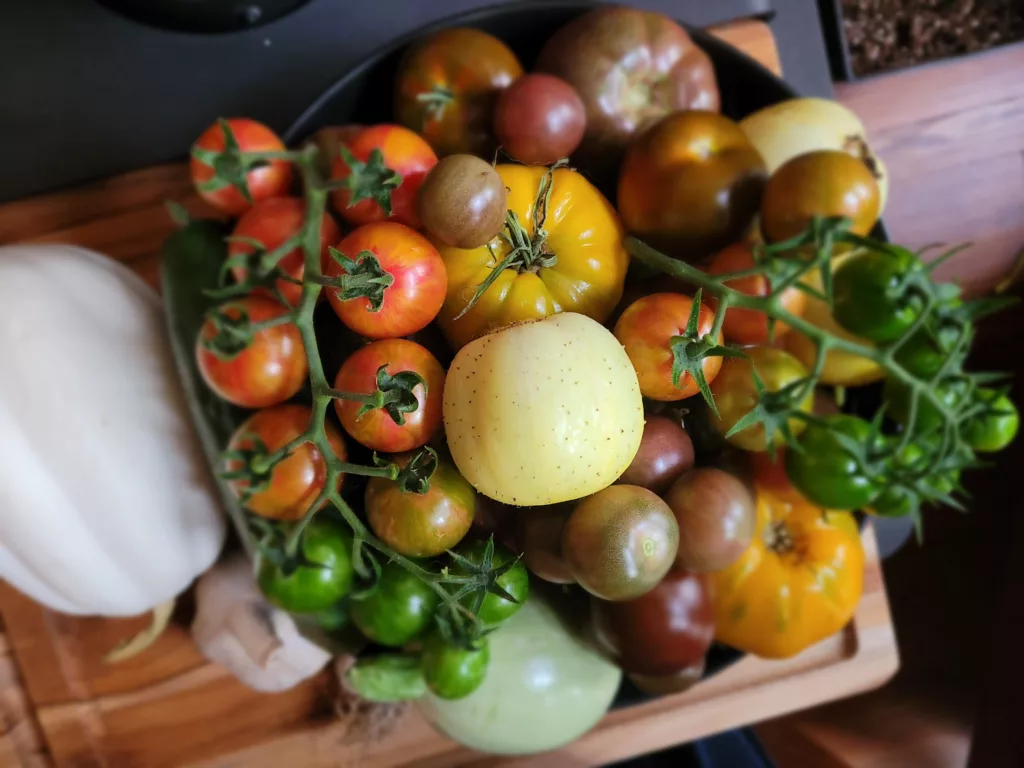
Determinate tomatoes tend to ripen early and all at once which is great for preserving batches of sauce, fermented salsa, or any kind of canned tomato.
You’ll end up with a table full of tomatoes, more like this:

You don’t have to pick them green like we do, we just do because the squirrels take bites of them if we don’t. This is also a light fraction of the full harvest we got. The brown bags are full of tomatoes too.
By understanding the average tomato plant yield and your family’s consumption, you’ll be able to calculate a reasonable ratio between growing determinate or indeterminate tomatoes!
1. How many tomatoes grow per plant on average
Endless types of tomatoes exist and their fruit production varies between all types of tomatoes. Each general type of tomato, however, produces an average volume of fruit.
Since indeterminate tomatoes grow and produce until terminated by frost, warmer climates, zones 7 and up, experience a higher-than-average yield per plant. Zone 6 climates are a good average yield marker for climate duration. Zones 3-5 can experience an average yield with a head start on plants.
You’ll gather a good sense of the average tomato yield to expect based on our tests here in Zone 5.
What is the average yield of a tomato plant by type?
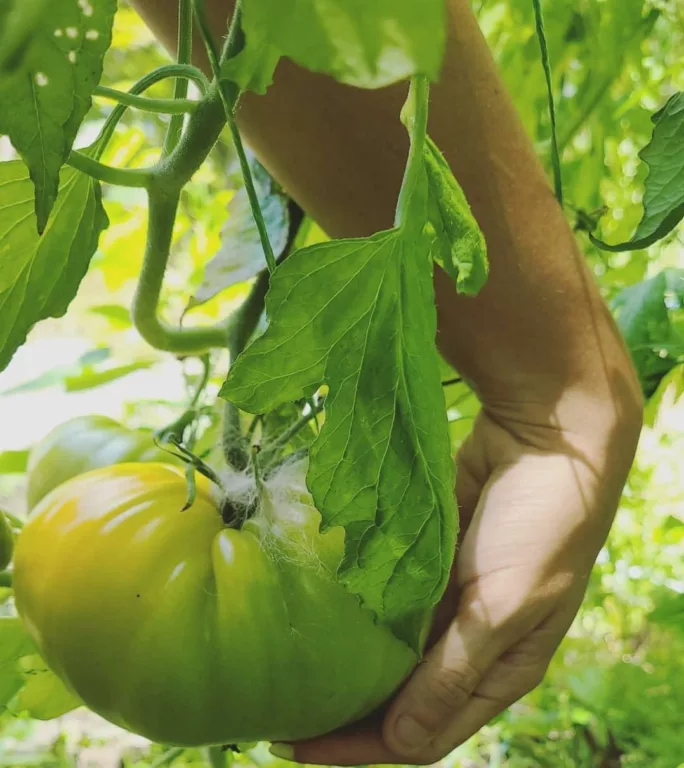
We have grown over 20 different kinds of tomatoes and have a general idea about each of their production volumes.
To find out the yield per plant from each, we grew Roma tomatoes, san marzano’s, beefsteak, and a variety of cherries, counted the number of tomatoes per plant, and weighed each harvest.
How many Roma tomatoes per plant?
Determinate and indeterminate Roma tomato varieties exist and produce differently.
Determinate Roma tomatoes are the most popular choice as they are paste tomatoes. Paste tomatoes are used in batches to preserve as sauces or tomato pastes for versatility when cooking.
Our Roma tomatoes averaged 31 fruits per plant and each fruit weighed between 4 and 5 ounces. The average harvest weighed 7.8 lbs per plant. Each plant was given the same care and growing conditions and was fairly consistent in size.
| Roma tomato 1 | 29 fruit | 7.2 pounds total fruit | ~4 ounces per fruit |
| Roma tomato 2 | 34 fruit | 8.5 pounds total fruit | ~4 ounces per fruit |
| Roma tomato 3 | 32 fruit | 8 pounds total fruit | ~4 ounces per fruit |
| Roma tomato 4 | 31 fruit | 7.7 pounds total fruit | ~4 ounces per fruit |
As reported by other gardeners, determinate tomatoes of any kind produce an average of 8 pounds per plant of about 22 tomatoes on a single healthy plant, as they are typically staked, and grow to a limited height.
Determinate plants are great for preserving sauces or tomato pastes, however, when the time comes it is a lot of work all at once if you’ve intended to do a lot of canning.
This is where indeterminate canning tomatoes such as San Marzano come in.
San Marzano tomato yield per plant?
San Marzano tomatoes are indeterminate and heirloom seeds. We grew San Marzano’s from Incredible Seeds.
All our tomatoes, including San Marzano, were sown indoors on March 22 and transplanted outside on May 24th. They had 21 weeks of growing time outdoors (147 days) before the first frost terminated our plants.
We grew 20 San Marzano’s last year and counted yields from 4 plants with 1.5-foot spacing.
On average, we harvested 159 tomatoes per San Marzano plant. The fruit size averaged 3.9 ounces. We totaled an average of 35.7 pounds of tomatoes per plant.
| San Marzano tomato 1 | 165 fruit | 40 pounds total fruit | ~3.9 ounces per fruit |
| San Marzano tomato 2 | 153 fruit | 37 pounds total fruit | ~3.9 ounces per fruit |
| San Marzano tomato 3 | 158 fruit | 38.5 pounds total fruit | ~3.9 ounces per fruit |
| San Marzano tomato 4 | 163 fruit | 39.7 pounds total fruit | ~3.9 ounces per fruit |
Indeterminate plants can continue producing until terminated by cold temperatures or other means.
We began harvesting tomatoes on August 16th for 8 weeks. The plants grew for a total of 29 weeks (203 days) from seed to final harvest.
If your growing season is longer than ours, or if you can start your tomatoes earlier, you’ll get a larger total harvest given adequate water, sunlight, temperature, and nutrients over a longer span of time.
The nice thing about indeterminate canning tomatoes is if you plant enough plants to yield a good number of tomatoes for preserving, you can do several batches of sauces or pastes rather than slaving away at them all at once.
How much does a beefsteak tomato plant yield?
We grow heirloom ‘classic beefsteak’ tomatoes by Baker Creek Seeds at 2-foot spacing. Having no idea what they would yield per plant before growing, we sowed several to find out! Out of all our beefsteak tomato plants, we tracked the harvest of 4.
On average, determinate beefsteak tomatoes yielded 12 pounds of fruit per plant. We yielded about 12 fruits per plant and each fruit was an average of 1 pound. This variety of tomatoes, however, is able to weigh up to 2 pounds per fruit with above-average conditions and skills.
| Beefsteak tomato 1 | 11 fruit | 11 pounds total fruit | ~16 ounces per fruit |
| Beefsteak tomato 2 | 12 fruit | 12 pounds total fruit | ~16 ounces per fruit |
| Beefsteak tomato 3 | 12 fruit | 12 pounds total fruit | ~16 ounces per fruit |
| Beefsteak tomato 4 | 14 fruit | 14 pounds total fruit | ~16 ounces per fruit |
Not confirmed by the seed suppliers, this tomato seems to be determinate.
Many tomatoes were big and some were small. The average fruit was 1 pound each and the difference between the big and small ones equaled a 1 pound per fruit average for each plant.
How many cherry tomatoes per plant?
Our favorite cherry tomato is the ‘black cherry’ from Baker Creek seeds. We also like to grow ‘black strawberry’ cherry tomatoes from Baker Creek Seeds.
Between all the types of cherry tomatoes we’ve grown, we noticed the number of clusters is more or less based on the size of the fruit. Larger cherry tomatoes produce fewer clusters, and smaller cherry tomatoes produce many more clusters.
Black cherry tomatoes produce 0.5-ounce fruit and black strawberry tomatoes are large cherry tomatoes at 1 ounce per fruit.
We noted the yield between these two types of cherry tomatoes. The results?
On average, you’ll get 300 or more cherry tomatoes per plant. Classic black cherry tomatoes yield 350 tomatoes per plant with 5-8 tomatoes per cluster, and 40-50 or more clusters. Black strawberry tomatoes yield 1-ounce fruits with 16-22 tomatoes per cluster and an average of 18 clusters.
| Black Strawberry tomato 1 | 310 fruits | 16 clusters |
| Black Strawberry tomato 2 | 324 fruits | 18 clusters |
| Black Cherry tomato 1 | 344 fruits | 49 clusters |
| Black Cherry tomato 2 | 358 fruits | 51 clusters |
Black cherry tomatoes are our go-to for yield and flavor. I also love the smaller size, the flavor tends to be rich rather than watery.
- How many tomatoes grow in 1 plant?
Before ever growing tomatoes, we wanted to know how many a single tomato plant will produce. We now understand why the answer isn’t so simple but can still be accurately estimated with a few considerations and general averages.
In general, determinate tomatoes produce 20-30 tomatoes per plant which is about 7-10 pounds of fruit. An adequate length of growing time, water, and sunlight will produce healthy plants that easily host this number of fruit.
Indeterminate tomatoes produce a range of 12-40 pounds of fruit per plant. As tomatoes continue to grow throughout the season, the longer the season, the greater the harvest per plant. Climate, nutrients, and overall care also affect your harvest rate and size.
The more advanced your growing skills and setup become, some growers achieve between 50-100 lb of fruit per plant.
How many clusters of tomatoes per plant?
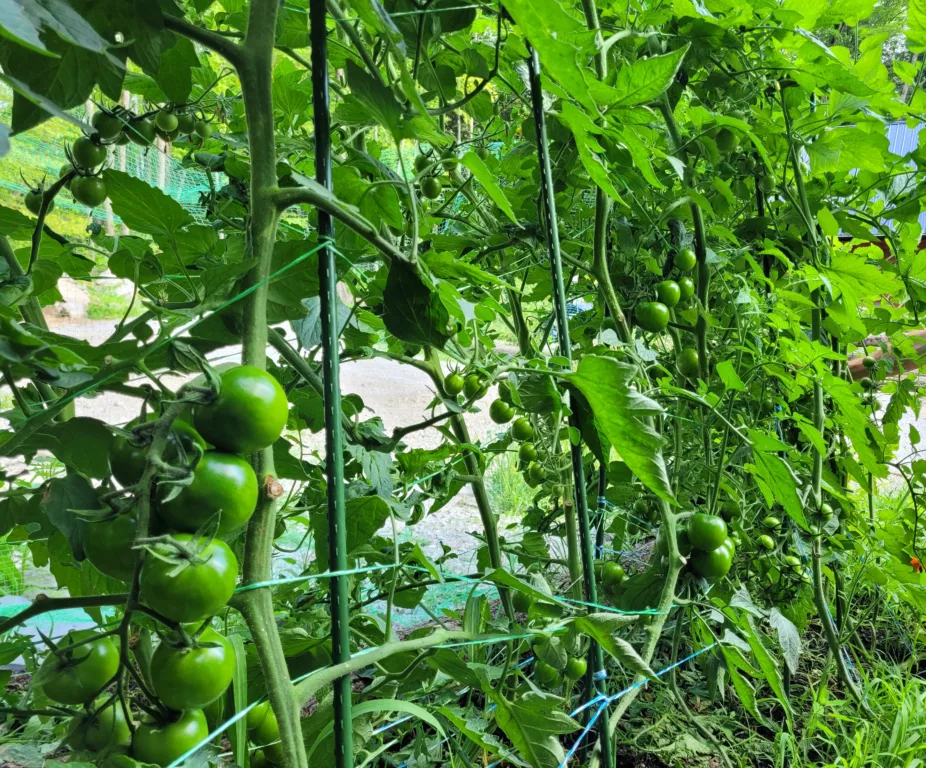
We love ‘tomatoes on the vine’ and if you’re looking to grow your own, you’ll need to know how many tomato clusters you’ll get per plant.
We’ve grown a wide variety of tomatoes. All kinds grow a ranging number of clusters, and I can provide you a general idea of how many clusters to expect from each type of tomato.
Indeterminate San Marzano tomatoes had an average of 14 clusters of 6-8 fruits per plant. Cherry tomatoes yielded 1-2 ripe clusters to harvest every other week per plant. With several plants, we had a steady weekly supply of ‘tomatoes on the vine.’
Indeterminate cherry tomato plants grow 30-60 clusters of tomatoes, on average, based on the size of the tomato and growing season length. The tomatoes closer to the main vine tend to grow bigger and ripen sooner than the tomatoes on the end of the cluster.
In general, determinate tomato varieties will grow fewer clusters than indeterminate tomatoes. The fruit clusters of determinate tomatoes, however, will all ripen at the same time. Indeterminate tomatoes produce more fruit clusters because they indefinitely grow until the plant dies.
2. How many tomatoes your family eats on average

To determine the number of tomatoes you consume, think about it on a per-meal basis.
What meals do you cook that include tomatoes?
What type of tomatoes goes into that meal?
How many, of that type of tomato, do you include in that meal?
You’ll want to answer these questions every year before you plan your garden, as your eating habits, or the number of people you cook for, will likely change over time.
Write them out, or enter these figures into this garden harvest calculator for a quick & easy answer every year. If not expired yet, use the coupon code GROWYOURGOALS for a discount.
On average, you’ll need 25-40 lbs of tomatoes per person for a year’s worth. This includes fresh eating, sauces, salsas, and all forms of tomato eating.
Of course, performing a personal family calculation will yield more accurate results.
Accurate results based on your own eating habits and frequency averages will minimize the use of water, effort, pots, soil, garden space, and all resources that go into growing your food.
3. How often you’ll eat tomatoes on average
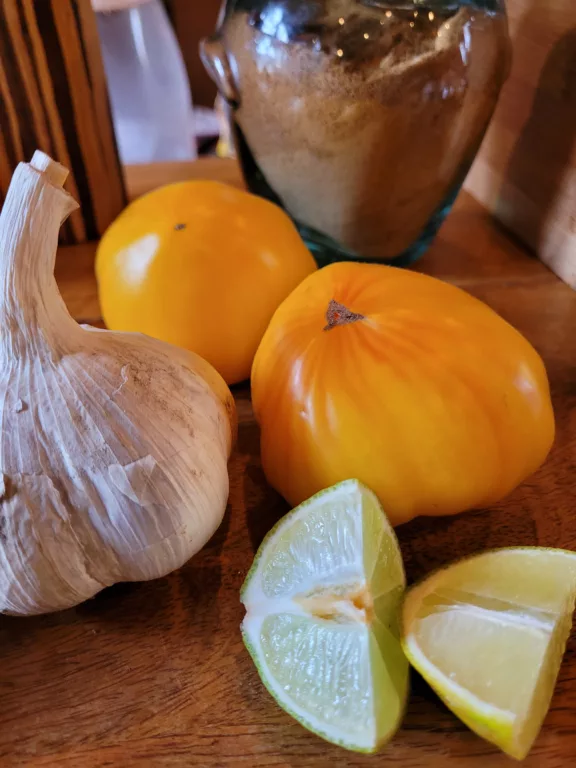
Now you know how many tomatoes you eat in a single meal.
Finally, the frequency you make those tomato-based meals determines how many tomatoes to plant per person.
In the calculator, you can adjust the weekly and monthly frequencies to adjust your consumption by season. You’ll also be able to change how many people you make tomatoes for since not everyone likes to eat tomatoes in the same ways.
How many tomatoes to plant per person for a year
You have 1 chance every year to grow the right number of tomatoes per person in your family. To get it right, hopefully, you’ve thought about your consumption habits.
In summer, while tomatoes are fresh we make and eat salsa, guacamole, pico, or some form of a fresh tomato-based dip or topping every day. It’s too delicious not to!
We plant 5 indeterminate tomatoes per person for an abundant 16 weeks of fresh eating. Half of these are large indeterminate varieties for salsa and sandwich making, and the other half are cherry tomatoes for fresh eating or adding to meals.
Eating fresh garden tomatoes is a short window here in Zone 5.
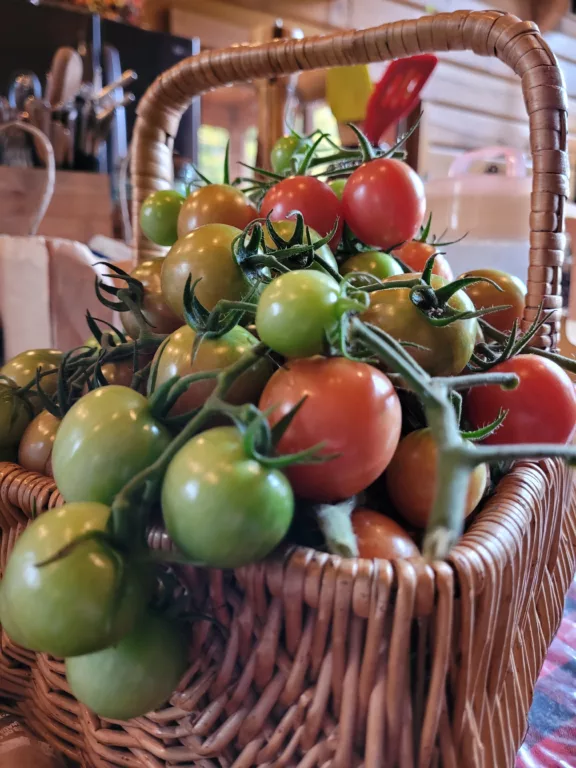
How many tomato plants per person for canning
The majority of our tomatoes are grown for fermenting or other methods of preservation.
On average, you need 30 lbs of tomatoes to make 9 pints of jarred sauce according to the National Center for Home Food Preservation. Three determinate tomato plants will yield enough tomatoes all at once for this purpose.
When we get ‘sick’ of canning, we throw unpeeled tomatoes into a big pan, simmer them down into a desired sauce, and freeze them in portioned flat thin containers. These can be consumed before the cans or ferments, and are easier to make.
Fermented salsa goes a longer way in jars than tomato-sauce canning as there are no wasted parts of the tomato. Just dice the tomato, and salt at the proper ratio, add onions and hot peppers, and secure a fermenting lid.
With the last of your tomatoes, dry them out in the sun!
4. How many tomato plants to maximize grocery savings
The number of tomatoes you should actually transplant in the garden is limited by a few things:
- Will it all fit in your garden?
- Do tomatoes grow well in your climate and produce at, or above, average?
- Are you good at growing tomatoes?
Related: Save Money & Grow the Vegetables That Cost You the Most
5. Average tomato training and care techniques
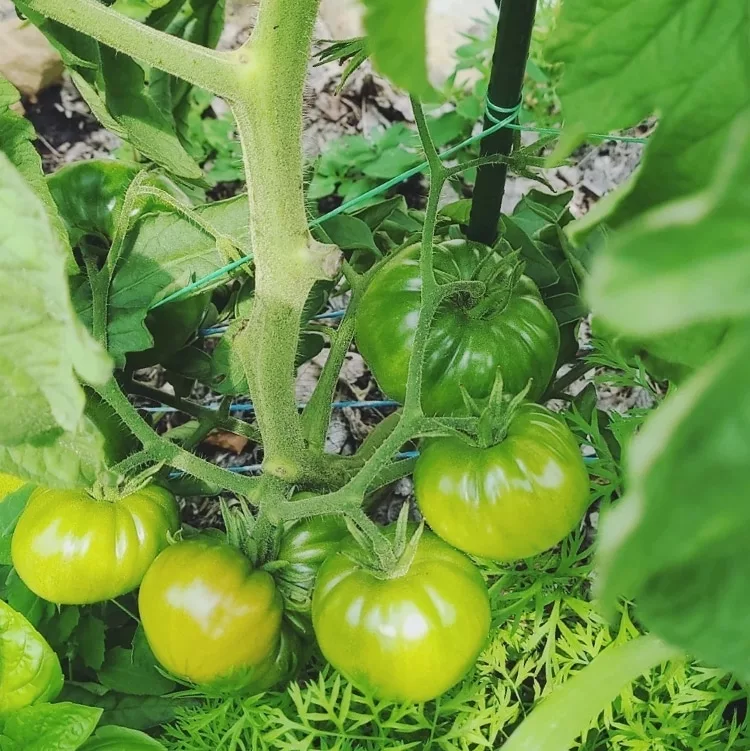
You’ll need to know basic tomato care for an ‘average’ tomato harvest from each plant. If you do nothing to care for your tomato plants, you’ll end up with a below-average result.
Tomatoes need about 18-24″ of spacing in rows for low-maintenance less intensive growing.
Square-foot intensive gardening allows for 12″ spacing in well-fed soils with good companion planting.
How do I get the most yield on my tomatoes?
The average gardener trains their tomatoes with stake support, and pruning to increase fruit production.
In general, stake all tomato plants to keep foliage off the ground and prune shaded foliage to increase airflow through the plant and prevent disease.
Determinate and indeterminate demand different styles of care. So it’s vital to know which tomatoes you’re growing so you can learn to manage them in a suitable way.
Average care for determinate tomatoes
- Prune the bottom of the plant up to the first cluster of fruit to keep ample airflow at ground level
- Don’t prune this plant like an indeterminate tomato
- Support plants with a cage so that when the fruit grows and ripens, the vines don’t break
- Grow in pots or in the ground
Average care for indeterminate tomatoes
- Prune the bottom of the plant up to the first cluster of fruit to keep ample airflow at ground level
- Prune the suckers ‘armpits’ as often as they grow in to maintain a single leading vine
- Support plants with a sturdy tall post, or strong tunnel trellis to support 6-12 foot heights.
- Grow in the ground, they will be too top-heavy for pots and demand more nutrients and water
- Harvest tomatoes often to keep new ones ripening
6. Average environmental conditions for tomatoes
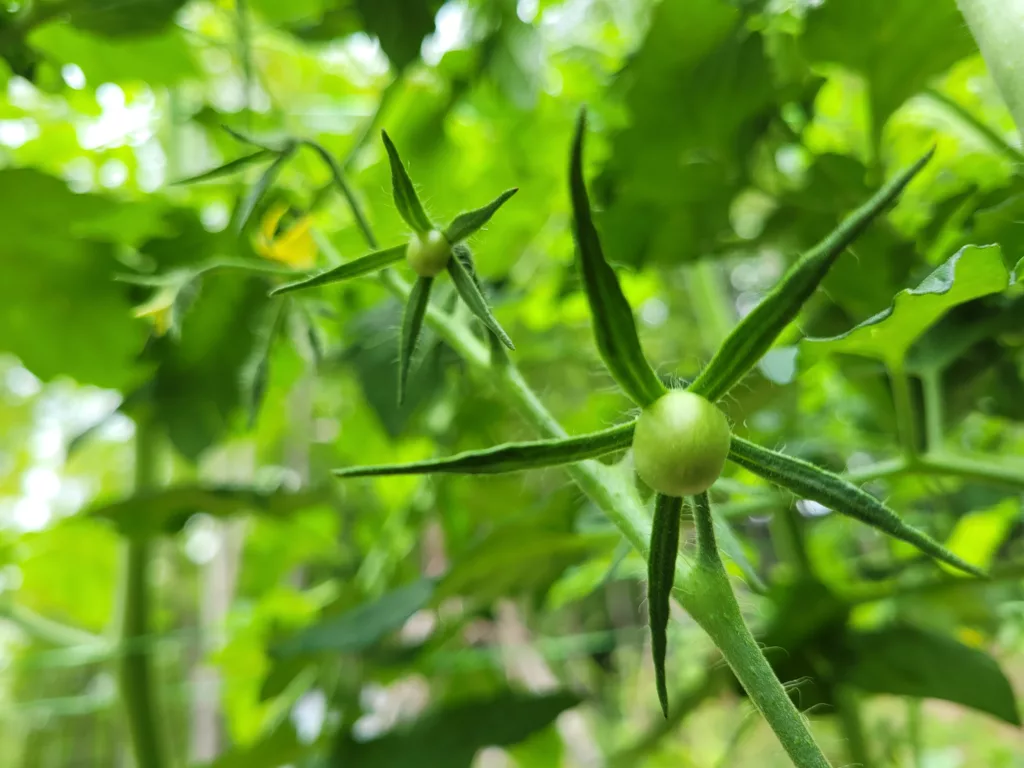
Every climate produces a more or less ideal environment for our vegetables. Your local gardeners will provide plenty of insights on the best-performing vegetables for your area.
- Tomatoes like full-sun; a minimum of 6-8 hours of full direct sunlight
- Water slowly and deeply. More water is needed when it is hot out and less when it is cooler.
- If you see the foliage is wilty, don’t panic! It might need water or is simply heat stressed: always check the soil before watering when foliage is wilting,
- If soil is moist, do not water – they are heat stressed.
- If soil is dry, water slowly and deeply!
- Avoid wetting foliage at all times to prevent disease opportunities.
- If you see the foliage is wilty, don’t panic! It might need water or is simply heat stressed: always check the soil before watering when foliage is wilting,
- Mulch slows evaporation, protects soil life, and is overall beneficial for any garden
- Save seed from the best tasting or largest, and healthiest heirloom tomatoes for acclimatized plants every year after
Up next: How many peppers to plant per person (Calculate your needs)
Recent Posts
There’s no shortage of full-sun ground covers for zone 4 climates! Each plant in this list can withstand the frigid temperatures and also enjoy the hot sun in summer. Full sun means that a plant...
There's no shortage of full sun ground covers, not even in zone 3! Zone 3 climates offer hot but short-lived summers and very cold winters. So each plant in this list can withstand the frigid...
